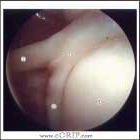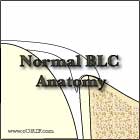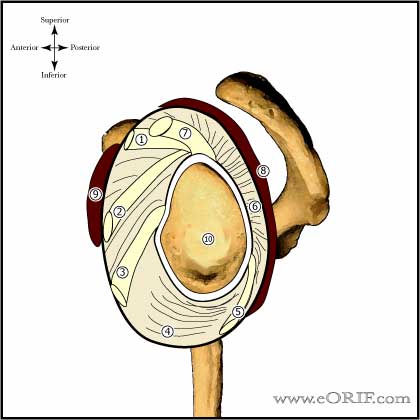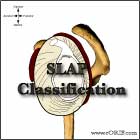|






|
SLAP Repair CPT
SLAP Repair Indications
- Failure of non-operative management
SLAP Repair Contraindications
- Active Infections
- Inadequate period of nonoperative treatment (relative)
SLAP Repair Alternatives
- Nonoperative treatment: 3 months of physical therapy focusing on strengthening the dynamic stabilizers. If non-op treatment fails to eliminat symptoms arthroscopic repair with suture anchors is indicated.
SLAP Repair Pre-op Planning / Special Considerations
- Ensure adequate anchors are available including any instrumentation needed for their insertion. Generally 3.0mm or smaller bioabsorbable or metallic suture anchors are utilized.
- Consider concomitant Subacromial decompression. (Coleman SH, AJSM 2007 pending)
SLAP Repair Technique
- Pre-operative antibiotics, +/- regional block
- General endotracheal anesthesia
- position. All bony prominences well padded.
- Examination under anesthesia.
- Prep and drape in standard sterile fashion.
- Perform Shoulder arthroscopy. Note that 73% of shoulders demonstrate some normal anatomic variant to the superior and/or anterior labrum that can be confused with a SLAP tear or anterior labral tear.
- Biceps root easily disrupted often into GH joint. Found in anterior and anterior-posterior Type II lesions
- Peel-back sign = entire superior BLC will shift medially as the arm is ER while in 70-90 degrees of abduction. Generally found in posterior and combined anterior-posterior Type II lesions. (Burkhart SS, Arthroscopy 1998;14:637)
- Drive-through sign = arthroscope can easily be moved through the GH joint from superior to inferior. Found in all Type II lesions
- Debride superior glenoid with shaver.
- Lightly decorticate the superior glenoid with an arthrscopic SLAP burr.
- Place anchors in superior glenoid. At least one suture anchor should be placed beneath biceps root with suture looping through posterior half of the biceps root, elimating peel back sign. Achors should be placed in @ 30° angle in relation to the articular surface for maximal bone support. (Lehtinen JT, AJSM 2003;31:257).
- Pass sutures. (Spectrum Suture passer or similar instrument).
- Tie arthroscopic knots with the labral side suture as the post.
- Posterolateral portal: consider for lesions involving posterosuperior labrum as it is nearly impossible to place an anchor in the round edge of the posterosuperior glenoid. This portal should be used without a cannula, just for drilling and anchor placement.
SLAP Repair Complications
- Recurrence / failure, Hardware failure / Anchor pull-out / Synovitis with biodegradable anchors, Infections, Stiffness, CRPS, Fluid Extravasation, Chondrolysis, Hematoma, Chondral Injury / arthritis
- Recurrence / failure
- Hardware failure / Anchor pull-out / Synovitis with biodegradable anchors.
- Infections
- Stiffness
- CRPS
- Fluid Extravasation:
- Chondrolysis: though to be related to heat from electo cautery or radiofrequency probes used during capsular release or capsular shrinkage.
- Hematoma
- Chondral Injury / arthritis
SLAP Repair Follow-up care
- Post-Op: Place in sling. Active wrist, hand ROM. Pendelum shoulder exercises. Avoid any active elbow flexion/supination. Keep elbow flexed and humerus internally rotated to avoid tension on biceps.
- 10 days: Start PT, continue sling for 4 weeks. Avoid any active elbow flexion/supination. Avoid excessive external rotation, especially in abduction to limit shear forces on the repair.
- 6 weeks: Discontinue sling. Progressive strenghening program.
- 3-6 months: Sport-specific rehabilitation.
- 6 months: Return to sport / unrestricted activity
- SLAP Repair Rehabilitation Protocol.
SLAP Repair Outcomes
- >85% good to excellent results. (Field LD, AJSM 1993;21:783).
- 92% return to competition for traumatic injuries, 64% for those without an inciting trauma. (Brockmeier SF)
SLAP Repair Review References
- Burkhart SS, The Cowboy's Companion: A Trail Guide for the Arthroscopic Shoulder Surgeon, 2012
- Burkhart SS, Burkhart's View of the Shoulder: A Cowboy's Guide to Advanced Shoulder Arthroscopy, 2006
- AANA Advanced Arthroscopy: The Shoulder: Expert Consult: Online, Print and DVD, 1e, 2010
- Gartsman GM, Shoulder Arthroscopy, 2e, 2008
- Maffet MW, in Delee and Drez Orthopedic Sports Medicine, 2nd ed, 2003
- OKU - Shoulder and Elbow 2nd ed, 2002
|